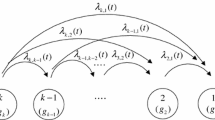Abstract
In Gåsemyr and Natvig (2001) partial monitoring of components with applications to preventive system maintenance was considered for a binary monotone system of binary components. The purpose of the present paper is to extend this to a multistate monotone system of multistate components, where the states more realistically represent successive levels of performance ranging from the perfect functioning level down to the complete failure level. We start out close to the spirit of Arjas (1989) by using a marked point process with complete monitoring of all components, and hence of the system, as the basic reference framework. We then consider a marked point process linked to partial monitoring of some components, for instance in certain time intervals. Incorporation of information from the observed system history process is then treated. Mainly, we assume that the inspection strategy is determined by the observed component history process only, with a possible exception of a full or partial autopsy after an observed change of state of , the system. Furthermore, we consider how to arrive at the posterior distribution for the relevant parameter vector by a standard simulation procedure, the data augmentation method. The idea is to extend the observed data to the complete component history process. The theory is applied to an electrical power generation system for two nearby oilrigs with some standby components, as considered in Natvig et al. (1986).
Similar content being viewed by others
References
E. Arias, “Survival models and martingale dynamics (with discussion),” Scandinavian Journal of Statistics vol. 16 pp. 177–225, 1989.
G. Casella and E. I. George, “Explaining the Gibbs sampler,” American Statistician vol. 46 pp. 167–174, 1992.
S. Chib and E. Greenberg, “Understanding the Metropolis-Hastings algorithm,” American Statistician vol. 49 pp. 327–335, 1995.
J. Gåsemyr and B. Natvig, “Bayesian inference based on partial monitoring of components with applications to preventive system maintenance,” Naval Research Logistics vol. 48 pp. 551–577, 2001.
B. Natvig “Multistate coherent systems,” In N. L. Johnson and S. Kotz (eds.), Encyclopedia of Statistical Sciences, Wiley: New York, vol 5 pp. 732–735, 1985.
B. Natvig, and H. W. Mørch, “An application of multistate reliability theory to an offshore gas pipeline network,” International Journal of Reliability, Quality, and Safety Engineering vol. 10 pp. 361–381, 2003.
B. Natvig, S. Sørmo, A. T. Holen, and G. Høgåsen, “Multistate reliability theory—a case study,” Advances in Applied Probability vol. 18 pp. 921–932, 1986.
M. Tanner and W. Wong, “The calculation of posterior distributions by data augmentation,” Journal of the American Statistical Association vol. 82 pp. 528–550, 1987.
Author information
Authors and Affiliations
Corresponding author
Additional information
AMS 2000 Subject Classification: Primary 96B25; Secondary, 62N05, 60K10
Rights and permissions
About this article
Cite this article
Gåsemyr, J., Natvig, B. Probabilistic Modelling of Monitoring and Maintenance of Multistate Monotone Systems with Dependent Components. Methodol Comput Appl Probab 7, 63–78 (2005). https://doi.org/10.1007/s11009-005-6655-5
Received:
Revised:
Accepted:
Issue Date:
DOI: https://doi.org/10.1007/s11009-005-6655-5




